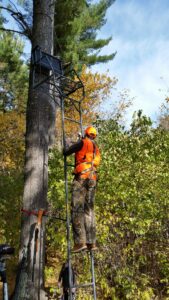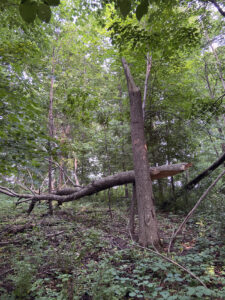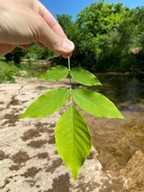
A Wisconsin hunter climbs into his tree stand. The Wisconsin Department of Natural Resources urges hunters to avoid placing their stands on or near ash trees because the trees may experience breakage of stems or branches due to damage from the emerald ash borer. / Photo Credit: Wisconsin DNR
By Wisconsin DNR
It’s time for deer hunters to begin scouting properties to identify potential locations for their deer stands this hunting season.
The Wisconsin Department of Natural Resources (DNR) cautions hunters to avoid placing deer stands in or near ash trees – a practice that presents a clear safety hazard.
Most ash trees in the southern two-thirds of Wisconsin are dead or dying due to the emerald ash borer (EAB), and infestations in the northern part of the state are rapidly expanding. Some areas already experience decline and mortality of ash trees. EAB has been confirmed present in all 72 Wisconsin counties, and unreported infestations are also likely to be present.
Tree stand accidents are the leading cause of serious injury to deer hunters. Research shows that one in four bowhunters has experienced a fall or near-fall from an elevated stand.

The snapped-off trunk of a green ash tree found at Theresa Marsh in June 2023. Infestation with emerald ash borer leaves ash trees unsafe for hunters to use as deer stands. / Photo Credit: Bill McNee, Wisconsin DNR
Dead and dying ash trees are structurally weaker than healthy trees, so they are not safe places to put deer stands. In many cases, it can be hard to tell if a tree has been infested by EAB, so hunters should place deer stands in other types of trees instead.
It is important to place and maintain tree stands carefully, regardless of the type of tree selected. Ash trees are of high risk because trees infested with EAB may unexpectedly snap at the trunk or drop large branches. Hunters should also be cautious around ash trees when on the ground, especially in windy conditions, as infested trees are susceptible to branch and stem breakage.
Find more information about EAB, including signs and symptoms of infestation, on the DNR’s website.
Basic Rules Of Tree Stand Safety
No matter the type of tree stand, basic safety rules should always be observed:
- Always wear a full-body harness (also known as a fall-arrest system). Connect to your tether line and keep that line short. The tether is designed to keep the hunter in their seat, not to catch them after they fall.
- Always have three points of contact while climbing into and out of the tree stand, whether it’s two hands and one foot, or two feet and one hand.
- Always use a haul line to raise and lower an unloaded firearm or bow into and out of the stand. The haul line can also be used to haul other things, such as a heavy backpack.
- Use a lifeline when climbing up and down, being sure to remain connected from the time you leave the ground to the time you put your feet on the ground.
The DNR offers a webpage with additional tree stand safety information, including a brief tree stand safety course.

Ash trees feature compound leaves, as shown in this close-up example of black ash leaves. / Photo Credit: Wisconsin DNR
How To Identify Ash Trees
Ash trees can be identified by looking for two key features:
- Opposite branching patterns, with two branches coming off the main stem directly across from one another.
- Compound leaves with 5-11 leaflets.
Find more information on ash trees and how to identify them at the University of Wisconsin-Madison Department of Entomology’s EAB website.
Avoid Spreading Forest Pests And Diseases
When traveling for hunting season, obtain firewood close to where it will be burned to reduce the chance of spreading tree-killing insects and diseases such as EAB, spongy moth and oak wilt.
Dry firewood with loose bark has the lowest risk of spreading harmful insects or diseases. Purchasing certified firewood is another option, as it is widely available and is seasoned or treated to eliminate pests and diseases. Bundles of certified firewood have a printed label showing certification.
